The Xiongnu (Hsiung-nu) emerged in areas that encompassed parts of today’s Mongolia in the last centuries BCE and by the early part of the second century BCE had consolidated power over much of the steppe and for some time held the upper hand in their relations with the powerful Han Dynasty in China. Xiongnu power declined gradually under pressure from the Han and other contenders for control of the steppes and Inner Asian trade routes. It was during the period of Xiongnu power though that we traditionally date the beginnings of the “Silk Road” across Eurasia; the Xiongnu obviously played a key role in the transmission of goods and culture. Their tombs have yielded treasures for the archaeologists, one of the first major discoveries being from the excavations carried out under the supervision of Russian scholars at Noin Ula (Noin Mountain) in Mongolia. The burials there dating from between the 4th or 3rd century BCE and 2nd century CE include appliqué carpets, with designs executed in part using silk thread and displaying human figures who seem to have “western” features. Various of the artifacts attest to connections with China and with western Eurasia.
While most of the Noin Ula artifacts were taken off to the Hermitage Museum in St. Petersburg (click here for the gallery), the museum in Ulaanbaatar displays some as well and many objects found at other sites by recent Mongolian and Mongolian-Korean expeditions. The exhibits change—in 2004, a section of one of the appliqué carpets was on display; in 2005 it was on loan in Germany but objects had been added from some of the recent excavations along with enlarged photographs of the excavations in progress.
Information about other recent excavations of Xiongnu sites is available online:

|
Model of Xiongnu tomb discovered in 1912 at Noin Ula, Batsumber, Tov prov., showing multiple chambers of burial.
|

|
Photograph of Xiongnu tomb excavated in 2000 by Mongolian-Korean expedition, Battsengel, Khudgyn Tolgoi, Arkhangai prov.
Pub.: Korean-Mongolian, p. 71.
|
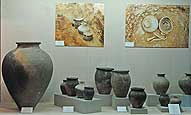
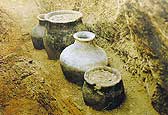
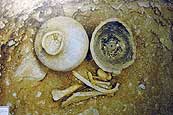
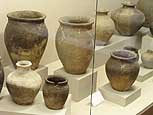
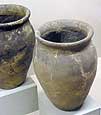

|
Xiongnu pottery, with photographs of pots in situ, taken during Mongolian-Korean joint expeditions, Battsengel, Khudgyn Tolgoi, Arkhangai prov., tombs 2 and 4.
Large jar on left from Noin Ula, Batsumber, Tov prov.
Pub.: Korean-Mongolian, p. 101; no. 71 (p. 103); National Museum, p. 15.
|

|
Pottery lamp.
Xiongnu period.
|


|
Cauldron. Bronze.
Xiongnu period. 500-200 BCE.
Teshig, Bulgan prov.
|

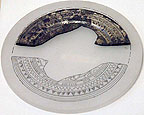
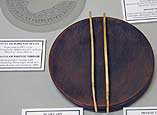
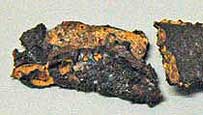
|
Various Xiongnu-period objects found by Mongolian-Korean Expeditions in 2000-2001, including Han bronze mirror fragment (1st c. CE, 15 cm. Dia., from Khurel tol, Morin Tolgoi, Altanbulag prov., tomb no. 1); chopsticks and wooden dish (former, 17.3 cm. long, 1st-3rd c. CE, Morin Tolgoi, Altanbulag sum, Tov prov., tomb no. 1); bronze bell (4.07 x 4.82 cm., Battsengel, Khudgyn Tolgoi, Arkhangai prov.); iron saw (1st c. CE, 19.0 cm., Battsengel, Khudgyn Tolgoi, Arkhangai prov., tomb no. 1).
Pub.: Korean-Mongolian, no. 36 (p. 70), no. 37 (p. 72), no. 48 (p. 86), no. 55 (p. 93).
|
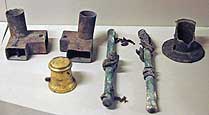

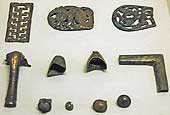

|
Miscellaneous bronze objects.
Xiongnu period.
Noin Ula (Batsumber, Tov prov.) and Salkhit grave sites (Salkhit, Selenga prov.).
Cf. National Museum, p. 15.
|


|
Xiongnu-period objects (3rd c. BCE-2nd c. CE) found at Noyon Ula (Batsumber, Tov prov.) and Takhiltiin hotgor, Mankhan, Khovd prov.
NB: Stirrups do not belong in display, as came into use after Xiongnu period.
|
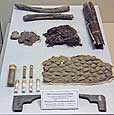

|
Xiongnu-period objects (3rd c. BCE-2nd c. CE) found at Noin Ula (Batsumber, Tov prov.).
|
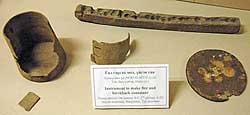
|
Wood and birchbark objects from Xiongnu burials at Noin Ula.
The wood with drill holes is part of a fire-starting kit.
|
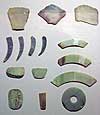
|
Jade from Xiongnu burials at Noin Ula (Batsumber, Tov prov.)
|
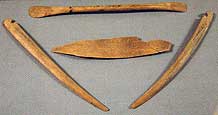
|
Bow parts.
Bone.
Tevsh mtn., Uvurkhangai prov.
Cf. Korean-Mongolian, no. 50, p. 89.
|
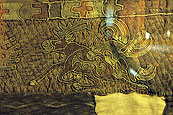
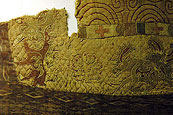


|
Carpet (details).
Mixed fabric, including wool and silk, appliqué design.
1st c. CE. 260 x 67.5 cm. (full size of piece, which is about 1/3 of a complete carpet).
Noin Ula, Batsumber sum, Tov prov.
Inv. No. A-268.
Pub.: Dschingis-khan, no. 15, p. 50. Cf. National Museum, p. 14, drawing of the analogous carpet now in Hermitage Museum (see Inv. no. 108).
|
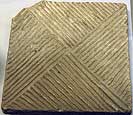

|
Construction materials, including tile.
Xiongnu period.
Earthenware.
Various locations incl. Khustyn bulag; Bayanjargalan, Tov prov.
Cf. Korean-Mongolian, nos. 28, 29, p. 60.
|































